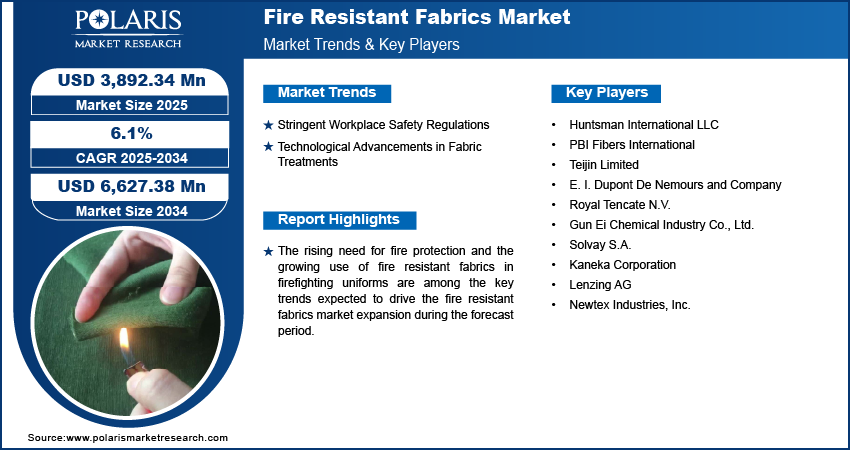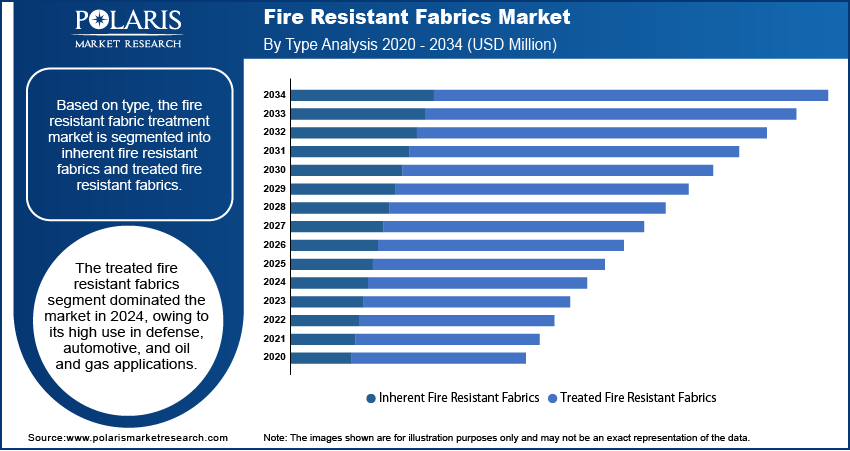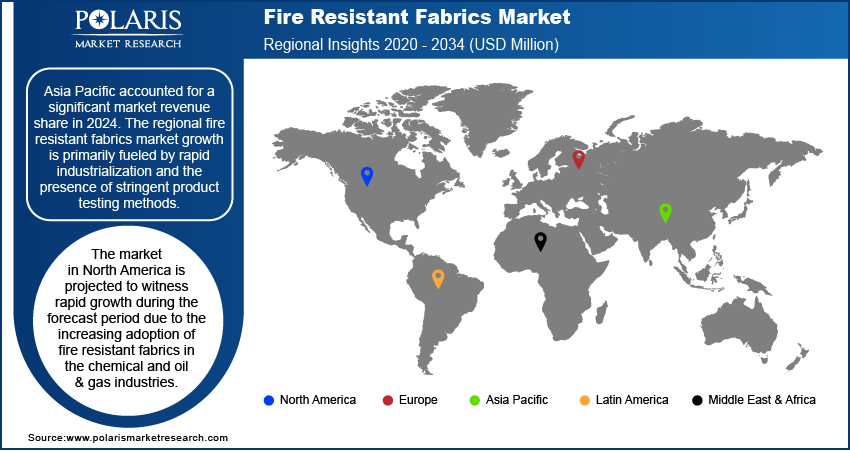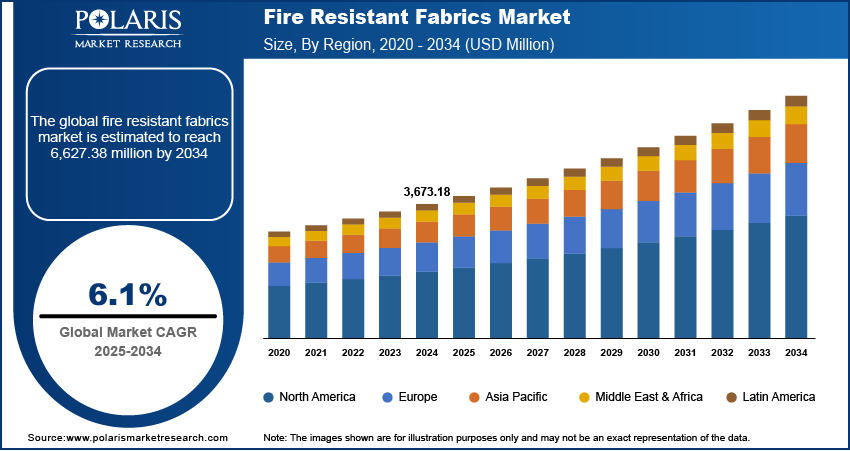
Fire Resistant Fabrics Market Size, Share, Trends, Industry Analysis Report
: By Type (Inherent Fire Resistant Fabrics and Treated Fire Resistant Fabrics), Application, End-Use Industry, and Region (North America, Europe, Asia Pacific, Latin America, and Middle East & Africa) – Market Forecast, 2025–2034
- Published Date:Aug-2025
- Pages: 119
- Format: PDF
- Report ID: PM1548
- Base Year: 2024
- Historical Data: 2020-2023
Market Overview
The global fire resistant fabrics market size was valued at USD 3,673.18 million in 2024, growing at a CAGR of 6.1% from 2025 to 2034. The market growth is primarily driven by increasing concerns about workplace safety and numerous applications of fire resistant fabrics across various industries.
Key Insights
- The treated fire resistant fabrics segment led the market in 2024, primarily due to growing demand for treated fabrics across automotive, defense, and oil & gas applications.
- The industrial safety segment is anticipated to register the fastest growth during the projection period, owing to increased adoption of fire safety measures in manufacturing industry.
- Asia Pacific held a significant market share in 2024. The regional market dominance is attributed to rapid industrialization and the presence of stringent product testing methods.
- North America is projected to register rapid growth from 2025 to 2034 due to high demand for fire resistant fabrics from the chemical and oil & gas industries.
Industry Dynamics
- The presence of stringent workplace safety regulations across sectors such as construction and chemicals is fueling the demand for fire resistant fabrics.
- Technological advancements in fabric treatments, including the introduction of technical textiles and metal nanoparticle fabrics, is driving market expansion.
- Growing investments by governments globally in safety improvements presents several market opportunities.
- High cost of production may present challenges to market growth.
Market Statistics
2024 Market Size: USD 3,673.18 million
2034 Projected Market Size: USD 6,627.38 million
CAGR (2025-2034): 6.1%
Asia Pacific: Largest Market in 2024
To Understand More About this Research: Request a Free Sample Report
Fire resistant fabrics are designed to withstand exposure to fire while providing protection and safety to the user. There are two main types of fire resistant fabrics—inherent fire resistant fabrics and treated fire resistant fabrics. Inherent fire resistant fabrics have fire resistance built into their chemical structures. Treated fire resistant fabrics gain their fire resistance properties through the application of flame retardant chemicals, which alter their chemical properties. These fabrics are critical in industries such as defense and military, emergency services, hospitals supplies, manufacturing, oil and gas, mining, space exploration such as space tourism, and others.
The fire resistant fabrics market growth is driven by factors such as increasing concerns about workforce safety and stringent government regulations related to workplace safety. The numerous applications of fire resistant fabrics across diverse industries also contribute to the market growth.
The rising need for fire protection and the growing use of fire resistant fabrics in firefighting uniforms are the key trends anticipated to drive the fire resistant fabrics market expansion in the coming years. In addition, increasing investments by governments worldwide in safety improvements creates lucrative market opportunities. The growing demand for fire resistant fabrics in home and commercial furnishing also plays a major role in driving the overall growth of the market.
Fire Resistant Fabrics Market Dynamics
Stringent Workplace Safety Regulations
Fire resistant fabrics are mainly used in safety apparel in end-use industries such as construction, chemicals, and oil & gas. These industries require the use of fire resistant fabrics owing to their hazardous working environments. With the imposition of stringent workplace safety regulations and the significant direct and indirect expenses related to workplace accidents, employers across these industries have exhibited a greater concern for workplace safety. This has significantly increased the demand for fire resistant fabrics, thereby having a favorable impact on the fire resistant fabrics market development.
Technological Advancements in Fabric Treatments
In the past decade, there have been major advancements in fabric treatment, especially in enhancing the fire resistant properties of these fabrics. These advancements aim to enhance the overall safety, performance, comfort, and durability of these technical textiles. For instance, advances in nanotechnology have enabled textile manufacturers to incorporate nanoparticles such as clay minerals and metal nanopartical fabrics to make the fabrics less flammable. These nanomaterials act as a barrier to mass and heat transfer, making the fabric more flame resistant. Similarly, phase change materials can regulate body temperature by absorbing excess heat and releasing it when the temperature drops. Such technological advancements in fabric treatments are contributing to the rising fire resistant fabrics market revenue.

Fire Resistant Fabrics Market Segment Insights
Outlook by Type Insights
The fire resistant fabrics market, based on type, is segmented into inherent fire resistant fabrics and treated fire resistant fabrics. The treated fire resistant fabrics segment dominated the market in 2024. Treated fire resistant fabrics undergo chemical treatment to increase their flame resistance. These fabrics are specifically created to slow down or stop the spread of fire, reducing fire risks and providing additional protection to wearers. The rising demand for treated fire resistant fabrics in defense, automotive, and oil and gas applications drives the dominance of the segment in the market.
Assessment by End-Use Industry Insights
The fire resistant fabrics market, based on end-use industry, is segmented into industrial safety, military, firefighting, and others. The industrial safety segment is projected to witness the fastest growth from 2025 to 2034. The use of flame resistant coatings provides a protective barrier and helps reduce the risk of fatal injuries. The increased adoption of fire safety measures in the manufacturing sector, along with mandatory regulations about workplace safety, is driving the fire resistant fabrics market demand for industrial safety.

Fire Resistant Fabrics Market Regional Analysis
By region, the report offers fire resistant fabrics market insights into North America, Europe, Asia Pacific, Latin America, and the Middle East & Africa. Asia Pacific accounted for a significant market revenue share of 37.2% in 2024. The regional market growth is primarily fueled by rapid industrialization and growth in industries such as healthcare, mining, and chemicals. Further, the presence of stringent product testing methods and compliance with government regulations drive the demand for fire resistant fabrics in the region.
The fire resistant fabrics market in North America is projected to witness rapid growth during the forecast period. The chemical and oil & gas industries in the region have experienced significant growth due to the growing demand for chemicals in various end-use sectors. The presence of flammable chemicals and gases in these industries increases the chances of fire occurrence, making it important for workers to have equipment made of fire resistant fabrics. This, in turn, is increasing the adoption of fire resistant fabrics in the region.

Key Players and Competitive Insights
The fire resistant fabrics market is characterized by intense competition, driven by factors such as innovative product offerings, technological advancements, mergers and acquisitions, and other strategic partnerships. Key players in the market strive to differentiate themselves in terms of pricing, quality, offering, and customer service. Also, they are making significant investments in R&D initiatives and focusing on strategic developments such as partnerships and collaborations to introduce new fire resistant fabrics that cater to diverse consumer needs.
Several market participants are prioritizing the development of sustainable and eco-friendly fire resistant fabrics that comply with stringent government regulations. The fire resistant fabrics market research report offers a market assessment of all the leading players, including Huntsman International LLC; PBI Fibers International; Teijin Limited; E. I. Dupont De Nemours and Company; Royal Tencate N.V.; Gun Ei Chemical Industry Co., Ltd.; Solvay S.A.; Kaneka Corporation; Lenzing AG; and Newtex Industries, Inc.
List of Key Companies
- Huntsman International LLC
- PBI Fibers International
- Teijin Limited
- E. I. Dupont De Nemours and Company
- Royal Tencate N.V.
- Gun Ei Chemical Industry Co., Ltd.
- Solvay S.A.
- Kaneka Corporation
- Lenzing AG
- Newtex Industries, Inc.
Fire Resistant Fabrics Industry Developments
April 2023: Teijin Limited introduced its new fire-resistant fabric, Tenax. According to Teijin, Tenax is a woven carbon fiber with a coating of thermoplastic polymer and has been developed to provide high heat, impact, and fatigue resistance.
April 2023: Royal Tencate N.V. announced the launch of its inherent flame-resistant fabric, Tecasafe 360. The company claims that Tecasafe 360 is the first flame resistant fabric on the market that provides stretch and flame resistance.
Fire Resistant Fabrics Market Segmentation
By Type Outlook
- Inherent Fire Resistant Fabrics
- Treated Fire Resistant Fabrics
By Application Outlook
- Apparel
- Non-Apparel
By End-Use Industry Outlook
- Industrial Safety
- Oil & Gas
- Utility
- Manufacturing
- Military
- Firefighting
- Others
By Regional Outlook
- North America
- US
- Canada
- Europe
- Germany
- France
- UK
- Italy
- Spain
- Netherlands
- Russia
- Rest of Europe
- Asia Pacific
- China
- Japan
- India
- Malaysia
- South Korea
- Indonesia
- Australia
- Rest of Asia Pacific
- Middle East & Africa
- Saudi Arabia
- UAE
- Israel
- South Africa
- Rest of Middle East & Africa
- Latin America
- Mexico
- Brazil
- Argentina
- Rest of Latin America
Fire Resistant Fabrics Market Report Scope
|
Report Attributes |
Details |
|
Market Size Value in 2024 |
USD 3,673.18 million |
|
Market Size Value in 2025 |
USD 3,892.34 million |
|
Revenue Forecast by 2034 |
USD 6,627.38 million |
|
CAGR |
6.1% from 2025 to 2034 |
|
Base Year |
2024 |
|
Historical Data |
2020–2023 |
|
Forecast Period |
2025–2034 |
|
Quantitative Units |
Revenue in USD million and CAGR from 2025 to 2034 |
|
Report Coverage |
Revenue Forecast, Market Competitive Landscape, Growth Factors, and Trends |
|
Segments Covered |
|
|
Regional Scope |
|
|
Competitive Landscape |
|
|
Report Format |
|
|
Customization |
Report customization as per your requirements with respect to countries, regions, and segmentation. |
FAQ's
The market was valued at USD 3,673.18 million in 2024 and is projected to grow to USD 6,627.38 million by 2034.
The market is projected to register a CAGR of 6.1% from 2025 to 2034.
Asia Pacific held a significant market revenue share in 2024.
A few of the key players in the market are Huntsman International LLC; PBI Fibers International; Teijin Limited; E. I. Dupont De Nemours and Company; Royal Tencate N.V.; Gun Ei Chemical Industry Co., Ltd.; Solvay S.A.; Kaneka Corporation; Lenzing AG; and Newtex Industries, Inc.
The treated fire resistant fabrics segment dominated the fire resistant fabrics market share in 2024.
The industrial safety segment is projected to witness the fastest growth during the forecast period.

